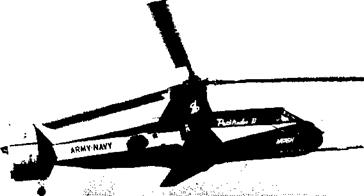Types of V/STOL Aircraft
There have been many schemes proposed for the design of STOL and VTOL aircraft. In VTOL aircraft, as in STOL aircraft, it is necessary to impose a minimum speed restriction. Thus a VTOL aircraft is defined as an aircraft with vertical takeoff and landing capabilities and cruising speeds equal to those of ordinary fixed-wing aircraft that perform comparable missions but from longer fields. This comparison with ordinary fixed-wing aircraft could apply as well to STOL aircraft in which the VTOL capability has been replaced by the takeoff and landing distance of 500 ft over a 50-ft obstacle.
In view of the speed requirement, helicopters and autogyros technically cannot be considered VTOL or STOL aircraft. The forward speed of the
usual rotary-wing aircraft is limited by the conflicting requirements of compressibility effects and retreating blade stall. At the higher forward speeds it is desirable to run at a high rotor rpm because of retreating blade stall, but, conversely, it is desirable to run at a lower rpm to avoid compressibility effects on the rotor. Listed below are different types of V/STOL aircraft or methods of accomplishing V/STOL performance. Most of these topics are covered in detail in later chapters.
Compound Aircraft
A compound aircraft is a combination of helicopter and fixed-wing aircraft. In forward flight the lift is transferred to the wing, thereby unloading
|
|
Fig. 1-2. A compound aircraft. (Piasecki Aircraft Co.)
the rotor. Forward thrust is provided by a propeller or a jet. In forward flight the rotor is allowed to autorotate or can be stopped and retracted into the fuselage. This type of aircraft is shown in Fig. 1-2.
Tail Sitters
A tail sitter is an aircraft, either jet or propeller-driven, of rather conventional outward appearance but with enough thrust and appropriate
controls to allow it to hover with the airplane axis in a vertical attitude. The coleopter, which is a ring-wing ducting a fan, also falls in this category.












